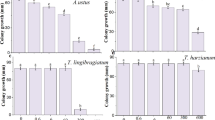Abstract
Wheat plants were grown in field experiments with five levels of zinc (Zn) fertilizer applied to plots in 1983. The plots were continuously cropped with wheat to allow the build up ofGaeumannomyces graminis var.tritici (Ggt). For experiments 1 and 2, there were high levels of Ggt in the second and third years while for experiment 3 there were high levels of Ggt incidence in the third and fourth year of continuous cropping. The Zn status of the wheat plants, grain yield, and the incidence and severity of take-all were measured for every experiment each year.
The Zn-deficient wheat plants were more severely infected by Ggt. However, increasing the Zn supply beyond that required for maximum grain yield had no further effects on decreasing the severity of take-all. The Zn concentration in the youngest emerged blade (YEB) suggested that the Zn status of the wheat plant ranged from severely Zn-deficient through marginal deficiency to sufficiency.
The Zn-deficient wheat plant was more susceptible to Ggt infection than Zn-adequate plants. The severity of take-all in the final year was still high in Zn-adequate plants, suggesting high levels of applied Zn (11.2 kg Zn/ha in 1983) had no fungistatic effect on Ggt.
Similar content being viewed by others

References
Allen JE (1961) The determination of Zn in agricultural materials by atomic absorption spectrophotometry. Analyst 86: 531–34
Chvapil M (1973) New aspects in the biological role of zinc: A stabilizer of macromolecules and biological membranes. Life Sci 13: 1041–1049
Cotterill PJ and Sivasithamparam K (1988) Survival of the take-all fungus in the presence and absence of susceptible grasses. Aust. J. Soil Res. 26: 313–322
Curl EA (1968) Control of plant diseases by crop rotation.Bot Rev 29: 413–79
Day PR (1965) Particle fractionation and particle size analysis. In ‘Methods of soil analysis’ (Ed CA Black) Agronomy Monograph No 9, p 545
Donald CM and Prescott JA (1975) Trace elements in Australian crop and pasture production, 1924–1974. In ‘Trace Elements in Soil Plant Animal Systems’ (Eds DJD Nicholas and AR Egan) pp 7–37. Academic Press: San Francisco, London
Gartrell JW and Glencross RN (1968) Copper, zinc and molybdenum fertilizers for new land crops and pastures, 1969. J Agric West Aust (4th series) 9: 519–21
Graham RD (1983) Effect of nutrient stress on susceptibility of plants to disease with particular reference to the trace elements. Adv Bot Res 10: 221–76
Hesse PR (1971) ‘A Textbook for Soil Chemical Analysis’. p 355. J. Murray: London
Huber DM (1980) The role of nutrition in defense. In ‘Plant Disease. An advanced treatise’. (Eds. J.G. Horsfall and E.B. Cowling). pp 381–406. Academic Press: New york
Johnson CM and Ulrich A (1959) Analytical methods for use in plant analysis. Bulletin of Californian Agricultural Station No 766
Kollmorgen JF Griffiths JB and Walsgott DN (1983) Effect of cropping seqeunce on saprophytic survival and carry over ofGaeumannomyces graminis var.tritici. pp 240–2. Proceedings of the 4th International Plant Pathological Congress American Phytopathological Society Minnesota USA
Lindsay WL (1972) Zinc in soils and plant nutriton. Adv Agron 24: 147–186
MacNish GC (1980) Management of cereals for control of take-all. J Agric West Aust (4th series) 21: 48–51
MacNish GC and Speijer J (1982) The use of ammonium fertilizers to reduce the severity of take-all (Gaeumannomyces graminis var.tritici) on wheat in Western Australia. Ann App Biol 100: 83–90
McIlveen WD and Cole H (1979) Influence of zinc on development of the endomycorrhizal fungusGlomus mosseae and its mediation of phosphorus uptake byGlycine max ‘Amsoy 71’. Agroc Emvorpm 4: 245–256
Northcote KH (1979) ‘A Factual key for the Recognition of Australian soils’. 4th Edition. RelliM Technical Publication: Glenside, South Australia
Reis EM, Cook RJ and McNeal BL (1982) Effect of mineral nutrition on take-all of wheat. Phytopath 72: 224–9
Reuter DJ and Robinson (1986) Plant analysis, An Interpretation Manual pp 38–99. Inkata Press: Melbourne
Sparrow DH and Graham KD (1988) Susceptibility of zinc-deficient wheat plants to colonization byFusarium graminearum Schw. Group 1. Plant Soil 112: 261–266
Walkley P and Black IA (1934) An examination of the Degtjareff method for determining soil organic matter and a proposed modification of the chromic and titration method. Soil Sci 37: 29–38
Welch RM, Webb MJ and Loneragan JF (1982) Zinc in membrane function and its role in phosphorus toxicity. Proceeding of the 9th International Plant Nutrition Colloquium pp 710–15
Zadok JC Chang TT and Konzak CF (1974) A decimal code for the growth stages of cereals. Weed Res 14: 415–21
Author information
Authors and Affiliations
Rights and permissions
About this article
Cite this article
Brennan, R.F. The effect of zinc fertilizer on take-all and the grain yield of wheat grown on zinc-deficient soils of the Esperance region, Western Australia. Fertilizer Research 31, 215–219 (1992). https://doi.org/10.1007/BF01063295
Received:
Accepted:
Issue Date:
DOI: https://doi.org/10.1007/BF01063295



